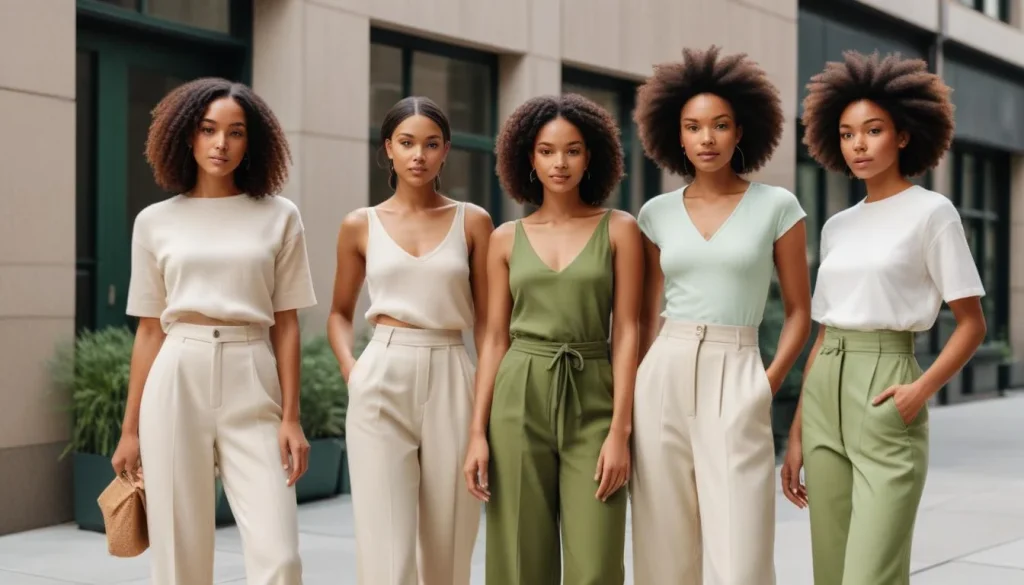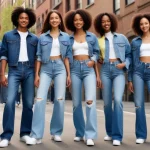Sustainable Women’s Fashion: 3 Eco-Friendly Brands You Need to Know in 2025

Sustainable women’s fashion in 2025 is defined by innovation and ethical practices, with leading eco-friendly brands pioneering transparent supply chains and utilizing recycled or organic materials to create stylish, guilt-free wardrobes for the conscious consumer.
Are you ready to transform your wardrobe with purpose? In 2025, sustainable women’s fashion is not just a trend; it’s a movement towards conscious consumerism and ethical choices. Join me as we explore the brands leading the charge.
The rise of sustainable fashion consciousness
The fashion industry’s environmental footprint has long been a concern, but in recent years, a significant shift has occurred. Consumers are increasingly demanding transparency, ethical production, and environmentally friendly practices from their favorite brands. This growing awareness has fueled the rise of sustainable fashion, moving it from a niche market to a mainstream imperative.
This evolving landscape means brands are now held to higher standards, not just for their designs but also for their impact on the planet and its people. The conversation has moved beyond just organic cotton to encompass a broader spectrum of sustainability, including circularity, fair labor, and reduced waste. It’s an exciting time to be a conscious consumer, with more choices than ever before.
Understanding ethical production
- Fair labor practices: Ensuring safe working conditions, fair wages, and no child labor throughout the supply chain.
- Transparent sourcing: Full disclosure of where materials come from and how they are processed.
- Community impact: Brands actively contributing positively to the communities where their products are made.
The commitment to ethical production is no longer a marketing gimmick but a fundamental pillar for brands aiming to succeed in the sustainable fashion space. It reflects a deep understanding that fashion should not come at the expense of human dignity or environmental health. This holistic approach ensures that every garment tells a story of responsibility and care.
Ultimately, the rise of sustainable fashion consciousness is about empowering consumers to make informed decisions that align with their values. It’s about recognizing that every purchase has an impact, and choosing brands that reflect a commitment to a better future. This collective shift is transforming the industry one ethical garment at a time.
Criteria for truly eco-friendly brands
Identifying genuinely eco-friendly brands requires a discerning eye, as ‘greenwashing’ remains a challenge in the industry. It’s not enough for a brand to simply claim sustainability; their practices must stand up to scrutiny across several key areas. From material sourcing to manufacturing processes and end-of-life solutions, true eco-friendliness is a comprehensive commitment.
We look for brands that prioritize sustainable materials, minimize their environmental impact, and uphold strong ethical labor standards. These criteria form the bedrock of what it means to be a truly responsible fashion brand in 2025, guiding consumers towards choices that benefit both people and the planet.
Innovative material usage
The foundation of sustainable fashion often lies in its materials. Look for brands utilizing organic cotton, recycled polyester, Tencel, hemp, and innovative bio-based alternatives. These materials significantly reduce water usage, pesticide exposure, and carbon emissions compared to conventional options. The commitment to sourcing and developing materials that are less impactful is a hallmark of truly eco-conscious brands.
- Organic cotton: Grown without harmful pesticides or synthetic fertilizers, protecting soil health and water quality.
- Recycled materials: Giving new life to waste, such as recycled polyester from plastic bottles or regenerated nylon from fishing nets.
- Bio-based fabrics: Materials derived from natural renewable resources like corn, wood pulp, or even algae, offering innovative alternatives.
Beyond the raw materials, the entire supply chain plays a critical role. Brands that are transparent about their manufacturing processes, ensuring minimal waste, reduced water consumption, and lower energy use, are setting a true standard. This holistic approach ensures that sustainability is embedded in every stage of a garment’s life cycle.

Furthermore, ethical labor practices are non-negotiable. Brands must ensure fair wages, safe working conditions, and respect for human rights across their entire supply chain, from the farmers who grow the fibers to the artisans who stitch the garments. Certifications from organizations like Fair Trade or GOTS (Global Organic Textile Standard) can provide an additional layer of assurance.
Finally, a commitment to circularity, designing products for longevity, repairability, and eventual recycling or biodegradability, distinguishes the leaders in sustainable fashion. These brands are not just reducing harm but actively contributing to a more regenerative system, moving away from the linear ‘take-make-dispose’ model.
Brand spotlight 1: Everlane’s conscious classics
Everlane has carved a significant niche in the sustainable fashion landscape by championing radical transparency. Their philosophy centers on revealing the true cost of their products, from materials and labor to transportation, empowering consumers with knowledge to make informed decisions. This commitment to openness has resonated deeply with a generation seeking honesty and integrity from brands.
Their aesthetic is built on timeless, high-quality essentials designed to last, challenging the fast fashion cycle by encouraging fewer, better purchases. Everlane’s approach to sustainability extends beyond just materials, encompassing ethical factories and a growing focus on circular initiatives, setting a benchmark for accessible, conscious style.
Ethical factories and transparency
Everlane’s ‘Ethical Factories’ initiative is at the core of their brand identity. They partner with factories that meet strict ethical standards, conducting regular audits to ensure fair wages, reasonable hours, and safe working conditions. This direct relationship with manufacturers allows them to oversee production closely and ensure that every garment is made with respect for the people involved. Their detailed factory profiles on their website provide an unprecedented level of insight for consumers.
- Factory visits: Regular, unannounced visits to ensure compliance with ethical standards.
- Worker well-being: Focus on fair compensation, healthy environments, and opportunities for growth.
- Public reporting: Detailed information about each factory, including audit results and employee demographics.
This commitment to ethical production is not just about avoiding exploitation; it’s about fostering positive relationships and ensuring that everyone involved in the creation of their clothing is treated with dignity. It’s a powerful statement in an industry often criticized for its opaque supply chains.
Beyond ethics, Everlane has made significant strides in sustainable materials. They have committed to using 100% recycled polyester in all their polyester products and are actively increasing their use of organic cotton and other low-impact fibers. Their denim line, for example, is produced in a factory that recycles 98% of its water, drastically reducing environmental impact.
Everlane also actively encourages consumers to embrace a ‘fewer, better’ philosophy, promoting longevity and versatility in their designs. Their emphasis on timeless pieces over fleeting trends helps to combat overconsumption and reduce textile waste, making them a formidable player in the sustainable women’s fashion movement.
Brand spotlight 2: Reformation’s climate-positive approach
Reformation has emerged as a powerhouse in sustainable fashion, renowned for its chic, feminine designs that don’t compromise on environmental responsibility. Their mission is to bring sustainable fashion to the masses, proving that being eco-friendly can also be incredibly stylish. What sets Reformation apart is their comprehensive, climate-positive approach, meticulously tracking and offsetting their environmental impact.
From the sourcing of low-impact materials to investing in green building infrastructure and supporting forest conservation, Reformation integrates sustainability into every facet of its business. They are a brand that truly walks the talk, offering transparency and accountability that consumers can trust, making them a go-to for those seeking fashionable yet responsible options.
Material innovation and impact tracking
Reformation is at the forefront of material innovation, prioritizing fabrics that have a minimal environmental footprint. They use a diverse range of sustainable materials, including Tencel Lyocell, recycled cashmere, organic cotton, and linen, carefully selecting each one based on its water usage, energy input, and waste generation. Their ‘RefScale’ tool publicly tracks the environmental impact of each garment, detailing its water, carbon, and waste savings compared to conventional alternatives.
- RefScale: A proprietary tool that quantifies the environmental savings of each product, promoting full transparency.
- Upcycled and deadstock fabrics: Utilizing existing materials to reduce waste and the demand for new production.
- Circular design: Designing garments for durability and encouraging customers to recycle their old clothes through their ‘RefCycle’ program.
Their commitment to material innovation extends to their entire supply chain, with rigorous standards for their manufacturing partners. Reformation invests in factories that prioritize energy efficiency, water conservation, and fair labor practices, ensuring that their beautiful garments are made responsibly from start to finish. This dedication to ethical sourcing and production is a cornerstone of their brand.

Beyond materials, Reformation actively works to be climate positive. They offset 100% of their water footprint and invest in projects that restore forests and protect biodiversity. Their commitment goes beyond merely reducing their impact; they strive to give back more than they take, setting an ambitious standard for the fashion industry as a whole.
For consumers looking for designs that are both cutting-edge and environmentally conscious, Reformation offers a compelling choice. Their blend of style, transparency, and a deeply embedded climate-positive strategy makes them a leading light in the future of sustainable women’s fashion.
Brand spotlight 3: Patagonia’s unwavering commitment to activism
While often associated with outdoor gear, Patagonia’s impact on sustainable women’s fashion is profound and far-reaching. They are not just a clothing brand; they are an environmental activist organization that happens to make high-quality, durable garments. Their unwavering commitment to environmental and social responsibility has set a global benchmark, influencing countless brands across various sectors.
Patagonia’s approach is holistic, encompassing everything from innovative recycled materials and fair labor practices to radical transparency and a powerful advocacy for environmental policy change. They encourage consumers to buy less, repair more, and demand better from the industry, embodying a truly regenerative vision for fashion.
Repair, reuse, recycle: the Worn Wear program
Patagonia’s Worn Wear program is a testament to their commitment to circularity and reducing consumption. Instead of encouraging endless new purchases, they actively promote the repair, reuse, and recycling of their garments. They offer free repairs, provide guides for self-repair, and facilitate trade-ins of used gear, extending the life cycle of their products significantly.
- Free repairs: Offering repairs for damaged Patagonia gear to minimize waste and prolong product life.
- Trade-in program: Allowing customers to exchange used Patagonia items for credit, which are then resold as ‘Worn Wear.’
- Educational resources: Providing tools and knowledge for customers to care for and repair their own clothing.
This program is a radical departure from the fast fashion model, challenging consumers to think differently about their relationship with clothing. By valuing longevity and repair, Patagonia demonstrates that the most sustainable garment is often the one you already own. This philosophy has inspired many other brands to consider similar initiatives.
Patagonia is also a pioneer in using recycled materials, especially recycled polyester and recycled down. They have invested heavily in developing supply chains that transform waste into high-performance fabrics, significantly reducing their reliance on virgin resources. Their commitment to organic cotton and other low-impact fibers further underscores their dedication to environmental stewardship.
Beyond product sustainability, Patagonia is a vocal advocate for environmental policy. They donate 1% of their sales to environmental causes, support grassroots activism, and even sued the Trump administration over public land protection. Their powerful voice and actions demonstrate that a business can be a force for good, driving both profit and planetary well-being. For conscious consumers, particularly those who value durability and environmental advocacy, Patagonia remains an unparalleled choice in sustainable women’s fashion.
The future of sustainable women’s fashion in 2025 and beyond
As we look towards 2025 and beyond, the trajectory of sustainable women’s fashion is clear: it will continue to evolve, innovate, and become an even more integral part of the global industry. The brands highlighted are just a few examples of the pioneering spirit driving this change, but their influence is undeniable. We can expect to see even greater emphasis on technological advancements, circular economy principles, and a deeper integration of social justice within the fashion supply chain.
The role of the consumer will also become increasingly powerful. Demand for transparency, accountability, and genuine eco-friendly practices will push more brands to adopt sustainable models. This collective effort, from innovators to informed shoppers, is shaping a fashion future that is not only stylish but also responsible and regenerative.
Emerging trends and innovations
The future of sustainable fashion promises exciting innovations in materials, moving beyond current organic and recycled options to embrace bio-fabrication, lab-grown textiles, and even materials derived from agricultural waste. Expect to see advancements in dyes that use less water and chemicals, as well as production methods that minimize energy consumption and waste.
- Bio-fabricated materials: Textiles grown from microorganisms, reducing reliance on traditional resource-intensive agriculture.
- Digital fashion and NFTs: Reducing physical production waste by creating virtual garments for digital consumption.
- Advanced recycling technologies: Chemical recycling processes that can break down complex textile blends into their original fibers for reuse.
The concept of ‘ownership’ in fashion may also transform, with rental and subscription models gaining more traction. These services offer access to a wider wardrobe without the environmental impact of constant purchasing, promoting a more circular and shared economy approach to clothing. This shift aligns perfectly with the desire for novelty without waste.
Furthermore, the integration of artificial intelligence and blockchain technology will enhance transparency and traceability throughout the supply chain. Consumers will be able to access detailed information about a garment’s journey, from farm to factory to their closet, ensuring authenticity and ethical production. This level of data will empower truly informed purchasing decisions.
Ultimately, the future of sustainable women’s fashion is bright, characterized by continuous innovation, a deepening commitment to ethical practices, and a growing community of conscious consumers. The brands leading this charge are not just selling clothes; they are selling a vision for a more responsible and beautiful world.
Navigating the sustainable fashion landscape
For consumers, navigating the sustainable fashion landscape can sometimes feel overwhelming, with a myriad of claims, certifications, and buzzwords. However, by focusing on a few key principles and being equipped with the right knowledge, you can confidently make choices that align with your values and contribute to a more sustainable industry. It’s about being an educated shopper and supporting brands that genuinely prioritize environmental and social well-being.
Understanding the nuances of what makes a brand truly sustainable, rather than just ‘greenwashing,’ is crucial. This involves looking beyond surface-level claims and digging into their practices, materials, and overall philosophy. Your choices have power, and by making informed decisions, you become an active participant in shaping a better future for fashion.
Key questions to ask when shopping
When considering a purchase, ask yourself critical questions that reveal a brand’s true commitment to sustainability. Does the brand provide clear information about its supply chain? Are its materials certified by reputable organizations? Do they have initiatives for repair or recycling? Transparency is a key indicator of genuine sustainability, allowing you to trace the journey of your clothing.
- What materials are used? Prioritize organic, recycled, or innovative low-impact fabrics.
- Where and how was it made? Look for ethical labor practices and transparent factory information.
- What is the brand’s overall mission? Does their ethos align with environmental and social responsibility?
Beyond the brands themselves, consider your own consumption habits. The most sustainable garment is often the one you already own. Embracing a ‘less is more’ philosophy, investing in high-quality, durable pieces, and caring for your clothes properly can significantly reduce your environmental footprint. Repairing, reusing, and even renting clothes are powerful ways to participate in a circular fashion economy.
Engage with brands on social media, ask questions, and support those who are genuinely striving for positive change. Your voice as a consumer is incredibly powerful. By collectively demanding higher standards, we can accelerate the transition towards a fashion industry that respects both people and the planet. Navigating this landscape becomes less about finding perfection and more about making consistently better choices.
Impact of your conscious fashion choices
Every purchase we make carries an impact, and in the realm of fashion, conscious choices reverberate far beyond our closets. Opting for sustainable women’s fashion isn’t merely a personal preference; it’s a powerful statement that supports ethical labor, environmental protection, and a healthier planet. Your decisions contribute to a larger movement, encouraging brands to adopt more responsible practices and fostering a virtuous cycle of sustainability within the industry.
By choosing eco-friendly brands, you directly support innovative materials, reduced pollution, and fair treatment for workers. This collective consumer power is one of the most effective drivers of change, signaling to the market that sustainability is not just a niche concern but a mainstream demand. It’s an investment in a future where fashion is both beautiful and benign.
Shaping a better industry
Your decision to buy from sustainable brands helps to shift market demand away from fast fashion’s exploitative and environmentally damaging practices. As more consumers prioritize ethical and eco-friendly options, brands are incentivized to transform their supply chains, invest in sustainable innovations, and be more transparent about their operations. This creates a ripple effect, pushing the entire industry towards greater responsibility.
- Reduced environmental footprint: Less water waste, fewer chemicals, and lower carbon emissions.
- Improved labor conditions: Supporting fair wages and safe working environments for garment workers.
- Innovation in materials: Driving the development and adoption of new, sustainable fabrics and production methods.
Furthermore, conscious fashion choices raise awareness among your social circles, inspiring others to consider their own consumption habits. Conversations about ethical sourcing, sustainable materials, and the true cost of clothing become more common, gradually normalizing sustainable practices and making them accessible to a broader audience. You become an ambassador for change.
The long-term impact of these choices is significant. By supporting brands that prioritize durability and circularity, you contribute to a reduction in textile waste, which is a massive environmental problem. Investing in pieces designed to last, and repairing them when needed, counters the throwaway culture that has dominated fashion for decades. This shift towards valuing longevity over fleeting trends is crucial for a sustainable future.
Ultimately, your conscious fashion choices are a vote for a better world. They demonstrate that style and ethics can coexist, that profit can be generated responsibly, and that the fashion industry can indeed be a force for positive change. Each sustainable garment you choose is a step towards a more equitable and environmentally sound future for all.
| Key Aspect | Brief Description |
|---|---|
| Material Innovation | Focus on organic, recycled, and bio-based fabrics to reduce environmental impact. |
| Ethical Production | Ensuring fair wages, safe conditions, and transparency across the supply chain. |
| Circular Economy | Designing for longevity, offering repairs, and promoting recycling to minimize waste. |
| Brand Transparency | Brands openly sharing their environmental and social impact with consumers. |
Frequently asked questions about sustainable fashion
Sustainable women’s fashion encompasses clothing produced with minimal environmental impact and ethical labor practices. This includes using eco-friendly materials like organic cotton or recycled fabrics, ensuring fair wages and safe working conditions for garment workers, and designing for durability and circularity to reduce waste.
Transparency is crucial because it allows consumers to verify a brand’s claims about sustainability and ethical practices. Brands that are transparent often disclose their supply chains, factory conditions, and environmental footprint, enabling informed decisions and combating ‘greenwashing’ where brands make misleading eco-friendly claims.
Look for specific certifications (e.g., GOTS, Fair Trade), detailed information on material sourcing and factory conditions, and a clear commitment to environmental initiatives. Genuine brands often have comprehensive sustainability reports and engage in circularity programs like repair or recycling, rather than just vague eco-friendly statements.
Choosing sustainable clothing reduces your environmental footprint by minimizing pollution and waste. It also supports fair labor practices, ensuring workers receive fair wages and work in safe conditions. Additionally, sustainable garments are often made to last longer, promoting a ‘buy less, choose well’ philosophy and saving you money in the long run.
As demand for sustainable fashion grows and production technologies advance, prices are likely to become more competitive. Innovations in materials and manufacturing, coupled with economies of scale, can help reduce costs. While initial investment might be higher, the longevity and ethical benefits often make sustainable clothing a more cost-effective choice over time.
Conclusion
The landscape of sustainable women’s fashion is rapidly transforming, driven by innovative brands and increasingly conscious consumers. By embracing transparency, prioritizing ethical production, and utilizing cutting-edge sustainable materials, companies like Everlane, Reformation, and Patagonia are not just selling clothes; they are shaping a more responsible and equitable future for the entire industry. Your choices as a consumer have immense power to support this positive shift, making a tangible difference with every purchase you make.



